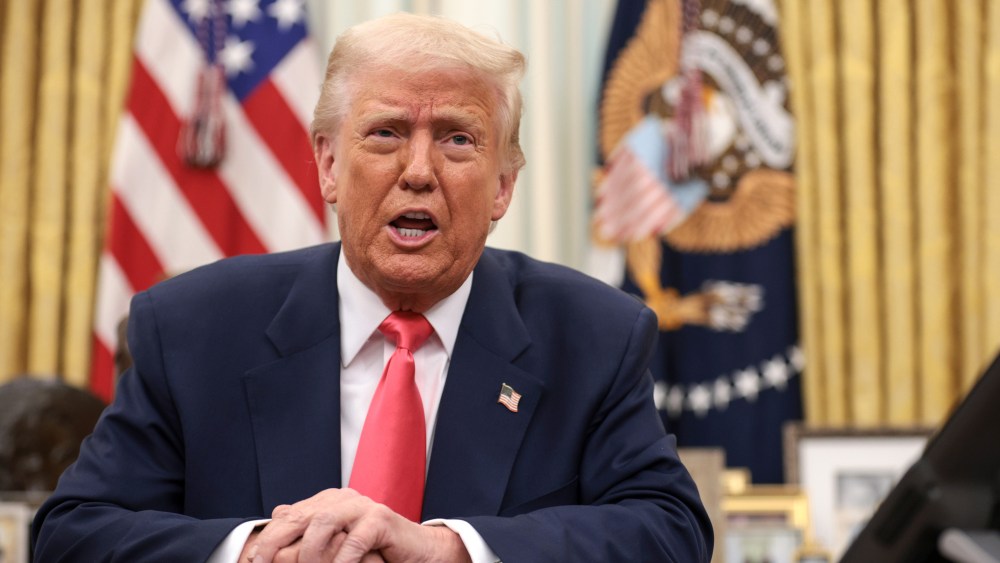After what HSBC dubbed “greedflation” – substantial price hikes amid euphoric post-pandemic purchasing – European luxury goods are set to become even more expensive in the wake of the Trump administration’s tariffs.
“We expect all brands to implement price increases in single-digit percentage in the U.S. in the coming weeks and to identify cost-savings opportunities in their U.S. and global operations to mitigate some of the tariffs impact,” Thomas Chauvet, luxury analyst at Citi, said in research note Thursday, highlighting worse-than-feared tariff levels affecting Swiss watches and Thailand-made jewelry, and better-than-expected levels for such U.K. brands as Burberry.
Tariffs were announced at 31 percent for goods made in Switzerland, 20 percent for those made in Europe, and 10 percent for U.K.-made goods.
You May Also Like
Chauvet noted that luxury stocks have eased 15 percent over the past month, the market pricing in at least a 10 percent downgrade to earnings per share due to the tariffs on European luxury goods and “recent signs of softening U.S. and global luxury demand.”
“The tariff impact to sector EPS might be overdone considering luxury companies’ intrinsic pricing power and relatively low price elasticity of demand,” Chauvet wrote. “However, how the U.S. (and global) luxury consumer responds to potentially reduced global economic growth remains unknown.”
According to Citi, the publicly traded companies with the highest revenue exposure to the U.S. in descending order are Birkenstock (47 percent of sales generated in the U.S.), Brunello Cucinelli (34 percent), Pandora (31 percent), Ferragamo (31 percent), LVMH Moët Hennessy Louis Vuitton (25 percent), Kering (24 percent) and Richemont (20 percent).

Meanwhile, the stocks least likely to be impacted given lower U.S. exposure are Moncler (13 percent), Swatch Group (15 percent), Prada Group (16 percent), Hermès International (17 percent) and Burberry (19 percent).
At midday in Europe, shares were down 12.4 percent for Pandora, 5.6 percent for Swatch, 4.6 percent for Brunello Cucinelli, 3.8 percent for LVMH, 3.5 percent for Kering and 3 percent for Hermès.
“Those companies with strong pricing power/higher-end positioning such as Hermès and Richemont might find it easier to mitigate the impact through pricing,” Chauvet noted.
Meanwhile, “weaker brands may decide to absorb a part of the cost instead of passing everything to the consumers which would then affect their gross margin,” Barclays said in a research note.
The bank estimated price increases across personal luxury goods at 4 to 10 percent since “tariffs are applied to the import price, rather than to the retail price.”
It was not immediately clear if the tariffs announced Wednesday night were new rates, or in addition to current.
“If the new 20 percent tariff includes this, we are discussing nothing. If it is incremental, we are discussing very little,” Luca Solca at Bernstein said in a research note. “What we should worry about, in case, are the second- and third-level impacts of the new American policies, if they precipitate a sharp global recession and stock market correction.”
Pandora, which produces its jewelry mostly in Thailand, but also Vietnam, India and China, calculated the total impact of the tariffs “before any mitigating actions” at 1.2 billion Danish kronor, or about 160.8 million euros.
It said it should be able to fully mitigate the 250 million kronor related to Canada and Latin America within the next 12 months.
“Pandora is actively exploring further mitigating actions to address the potential remaining DKK 950 million impact, including price increases and supply chain set-up,” it said.
European fashion bodies and executives started to weigh in, expressing dismay about the tariffs.
“The new tariffs the USA has applied on goods from the U.K. will be of great concern to British fashion brands, which will have to make the problematic compromise between raising prices or eating into already slim margins on U.S. sales,” said Caroline Rush, chief executive officer of the British Fashion Council.
She added that, as a result of tariffs, American fashion consumers will likely see prices rise on imported fashion.
“The U.S. is a key market for U.K. fashion exports, and any governmental action that could dampen U.K. trade or opportunity within the U.S. market should be avoided or reversed where possible,” said Rush. “The BFC is working closely with the U.K. Department of Business and Trade to advocate for tariff-free entry for U.K. fashion goods into the U.S. market and to support global U.K. fashion exports.
“We will continue to voice the fashion sector’s concerns to the U.K. and U.S. governments. We encourage brands impacted by the change in the U.S. tariff regime to provide evidence and data to the BFC so we can make the strongest possible case,” she added.
Adam Mansell, CEO of the U.K. Fashion and Textile Association, said: “The U.S. is the UK’s second-largest export market for fashion and textiles, and the new USs tariff regime will benefit no-one. It will lead to reduced exports from the U.K. and will impact U.K. fashion and textile manufacturers, at time when they are already facing unprecedented cost increases.
“Although the 10 percent tariff on UK exports is lower than the 20 percent on EU products, it adds to existing tariffs, making some luxury fabrics from the UK subject to a 35 percent tariff in the U.S.,” he continued. “At the same time, UK retailers and brands that manufacture in countries such as Vietnam and Bangladesh and ship directly to the U.S.A. will face huge increases in costs. The new U.S. tariffs will also mean increased prices for U.S. consumers, and it will make the cost of raw materials for U.S. manufacturers more expensive.”
Helen Brocklebank, CEO of Walpole, said: “We are deeply concerned about the impact of the newly announced tariffs on the British luxury sector.”
She noted the sector’s exports account for 22 percent – or 12.3 billion pounds – of the U.K.’s total exports
“These tariffs will not only create barriers for U.K. businesses, but also penalize American consumers who value the creativity, craftsmanship and heritage of British luxury goods,” said Brocklebank.
“We are in continued contact with the U.K. government, and we welcome their intensive efforts to reach a resolution with the U.S. administration and continue to support a measured, diplomatic approach to securing a fair and mutually beneficial outcome,” she continued.
In Italy, Sergio Tamborini, president of Confindustria Moda, said: “Fashion, in its global dimension, is being called upon to redesign its routes and supply chains. Given the structure of the supply chain, the main concerns are not only the U.S. tariffs on European products and their direct impact in terms of lost revenue, but also the broader effects of these measures on production and distribution stages, starting from raw material sourcing to garment manufacturing.”
He said that the additional challenge is to chose between “further adjusting their pricing or selecting new destinations for production and trade.”
To address international challenges, Confindustria Moda is working with institutions. “However, the solutions adopted by Brussels will also be crucial in shaping Europe’s protectionist policy,” said Tamborini.
According to Confindustria Moda Ufficio Studi Economici, the trade of Textile-Clothing from Italy to the U.S. from January to December 2024 amounted to 2.8 billion euros reflecting a decline of 0.7 percent compared to 2023.
During this period, in the ranking of top export destinations, the U.S. ranked as the third-largest market, accounting for 7.4 percent of total textile-clothing exports, with a predominant share of the clothing sector at 2.3 billion euros. The best-performing sectors were silk spinning, home textiles and hosiery.
“Inevitably, these areas are expected to experience a contraction in their growth prospects in the United States,” concluded Tamborini.



